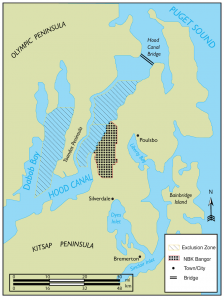
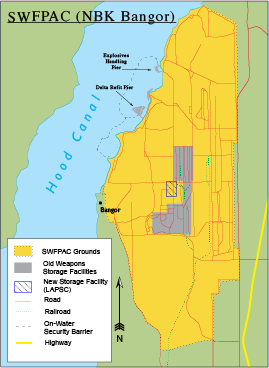
Brennan Stevenson

Along a scenic tract of the northern Hood Canal on Washington State’s Kitsap Peninsula, and across the ebbing, blue-green waters from the Toandos Peninsula, sits an example of the ongoing militarization of western Washington and the Puget Sound.
Officially designated by the Navy as the Strategic Weapons Facility Pacific (SWFPAC), it is more commonly known or referred to as Naval Base Kitsap (NBK)-Bangor. The installation at Bangor is a submarine base and nuclear weapons arsenal, covering 8,572 acres and controlling roughly four miles of shoreline (Carter 1974). In its current capacity, SWFPAC stores and maintains Trident-II intercontinental ballistic missiles, as well as porting nuclear-powered Ohio-class submarines (see Trident submarines). The base at Bangor was one of several separate naval installations on the Kitsap Peninsula that were incorporated into the greater Naval Base Kitsap (NBK) complex in 2004.
Bangor History
The Bangor facility began serving the Navy in the mid-1940s as the Bangor Ammunition Depot, a naval magazine storing ammunition meant to be used by warships bound for the Pacific theater during World War II (Casserly 2011). On the grounds of helping accelerate the end of the war with Japan, plans were approved by the Secretary of the Navy on April 28, 1944, with construction of the depot beginning in June that year. Many local residents were evicted to construct the depot (Drosendahl 2018).
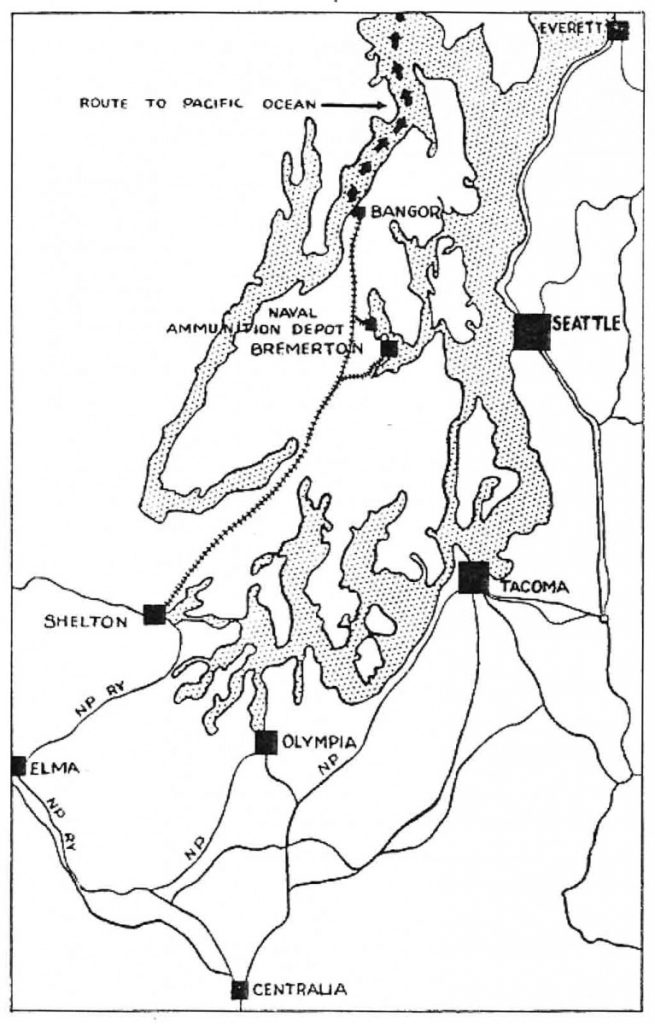
Cold War Origins of SWFPAC
Bangor’s role as a nuclear weapons facility began during the 1960s, coinciding with a post-World War II defense industry boom (aided partly by the outbreak of the Korean War). Total wages for both military and civilian Defense Department employees in the state of Washington increased from $193 million in 1947, to nearly $430 million by the early 1960s (Casserly 2011). In the western United States at the time, Washington was behind only Texas and California in terms of the share of defense funds received by the state (Casserly 2011).
SWFPAC was tasked with the handling and maintenance of Trident’s predecessors, the Polaris and Poseidon Intercontinental Ballistic Missiles (ICBMs), before it was selected to become the home of the first group of Trident missiles and the Ohio-class submarines designed to carry them (Carter 1974) . In 1973, the Navy announced plans to use the Bangor Naval Annex as the first base for Trident-carrying submarines. After the base was recommissioned in 1977, the first of the Trident submarines arrived at Bangor in Summer 1982.
Nuclear Weapons at Bangor

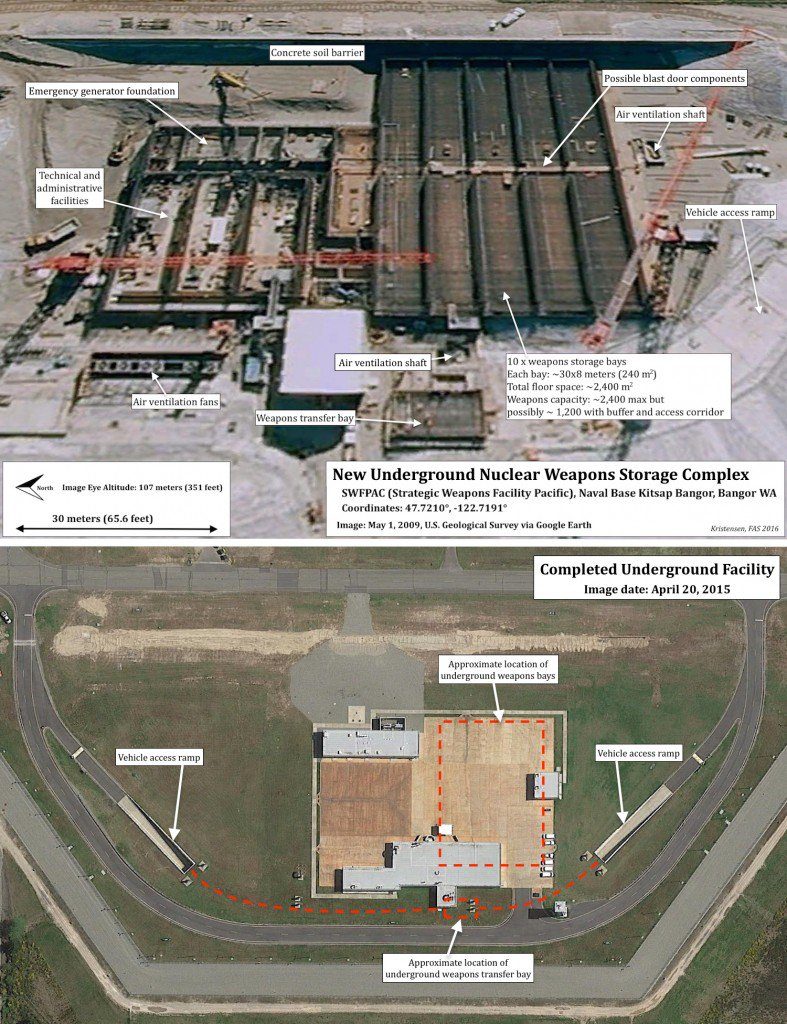
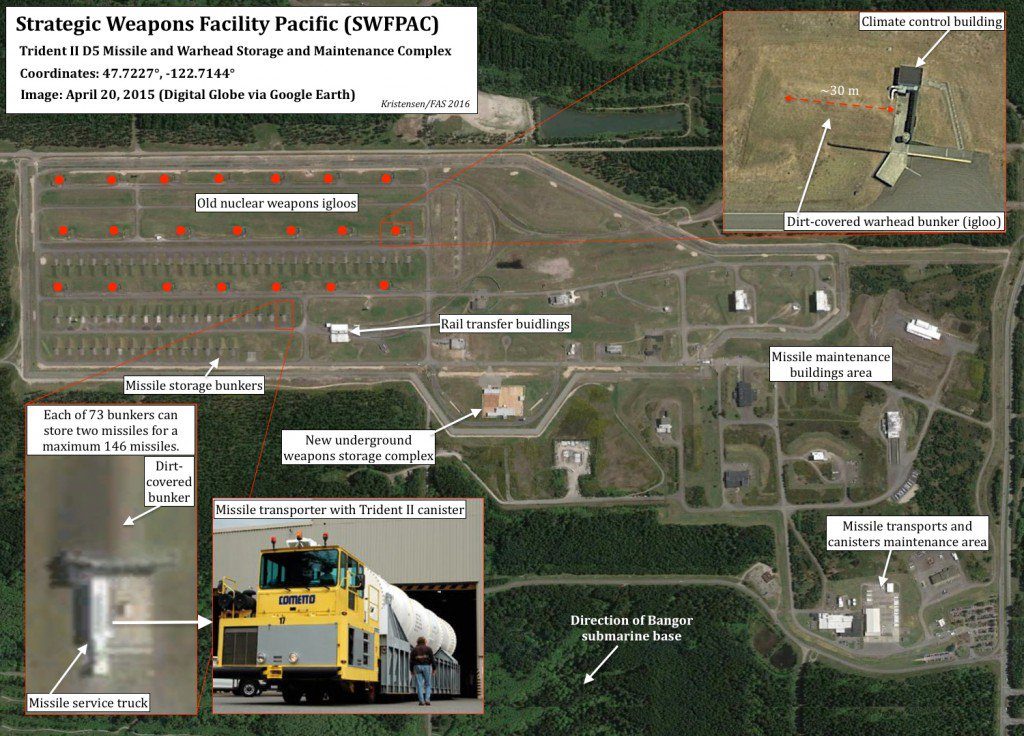
Western Washington’s Military Economy
From the exploration of the region to the protection of overland migrants to the conquest of Native Americans, the U.S. military played a significant role in shaping the West. Since the mid-nineteenth century the armed services also influenced the economies and societies of western communities. Economic underdevelopment, whether real or perceived, impelled local leaders to try to spur the growth and prosperity of their communities by fostering a booster culture. One significant strategy adopted by western boosters between the late 1800s and the last decades of the twentieth century involved political and business elites cultivating economically beneficial relations with the military as part of a security codependency (Casserly 2011).
By the time the submarines had arrived at Bangor, attitudes around the Puget Sound region had shifted away from enthusiastic support for the expansion of military industrial projects and bases, especially those facilities involved in the housing, maintenance, and deployment of nuclear weapons. Concurrent with the Women’s Peace Camp actions at Greenham Common in the United Kingdom, the environmentally conscious anti-base/anti-nuclear weapons movement had gained traction in Washington State by the 1980s. Taking inspiration from and building on the momentum generated by the camp at Greenham Common, a Puget Sound Women’s Peace Camp was established on June 18, 1983. However, the Puget Sound Women’s Peace Camp was not sited near Bangor or on the Kitsap Peninsula, but instead took up a position and demonstrated across the street from Boeing’s Aerospace Center in Kent, Washington (Buehler 1985).
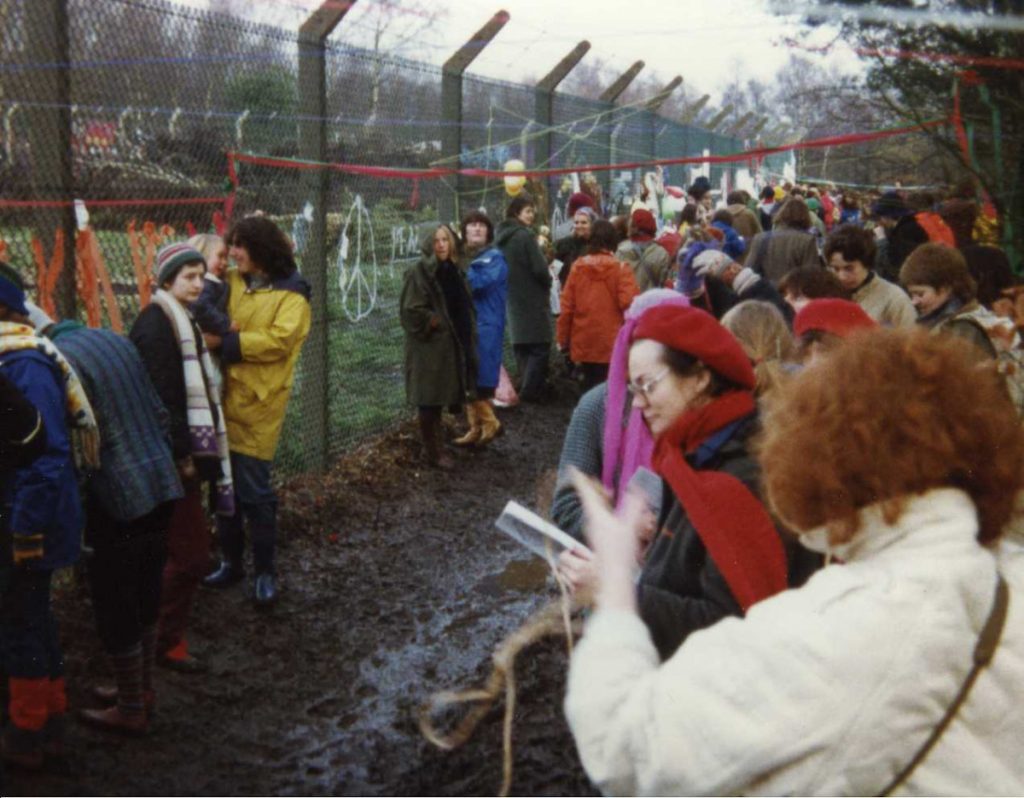
Newfound concerns, skepticism, and criticism put the Kitsap Peninsula, Bangor and the Trident missiles at the center of a debate questioning the necessity, sustainability, and safety of Washington state’s deep relationship with the military-industrial complex.
Postscript: The Navy revealed in 2020 that it “will test the drinking water of residents whose homes border Naval Base Kitsap to determine whether there are dangerous levels of contamination from firefighting foam once used at Bangor. If any homes in areas bordering the base are found to have what are commonly called PFAS in dangerous concentrations, they will receive bottled water indefinitely, ‘until a long-term solution is implemented,’ the Navy told the Kitsap Sun” (Farley 2020). (See Water Contamination on Whidbey Island).
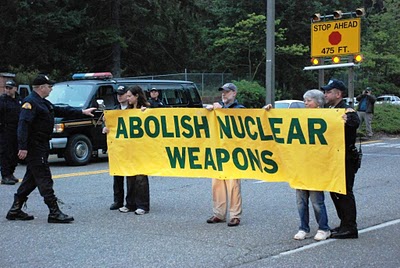
Sources
Buehler, J. (1985). The Puget Sound Women’s Peace Camp: Education as an Alternative Strategy. Frontiers: A Journal of Women Studies 8(2), 40-44.
Carter, L. J. (1974). Trident: Lawsuit Challenges the Navy’s Billion-Dollar Baby. Science 185(4155), 928-929.
Casserly, B. G. (2011). Puget Sounds Security Codependency and Western Cold War Histories, 1950–1984. Pacific Historical Review 80(2), 268-293.
Drosendahl, G. (2018, April 13). Naval Base Kitsap-Bangor Segregation Area. HistoryLink.
